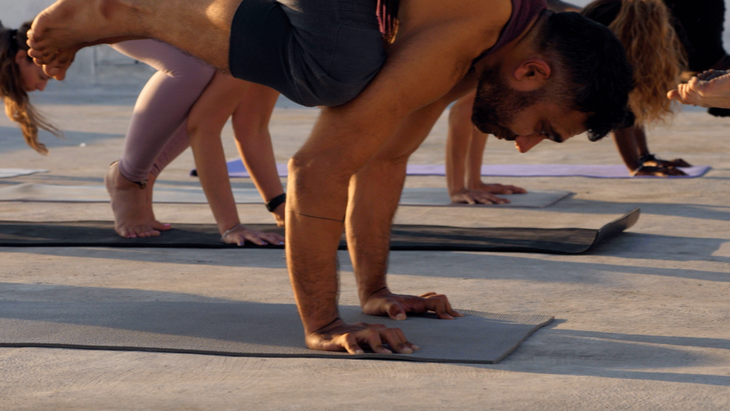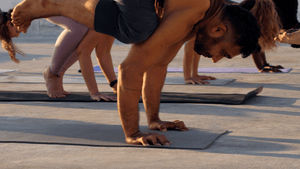Heading out the door? Read this article on the new Outside+ app available now on iOS devices for members! <a href="https://outsideapp.onelink.me/wOhi/6wh1kbvw" class="o-content-cta-link" data-analytics-event="click" data-analytics-data="{"name":"Element Clicked","props":{"destination_url":"https://outsideapp.onelink.me/wOhi/6wh1kbvw","domain":"<>","name":"in-content-cta","type":"link"}}”>Download the app.
Crow Pose is commonly considered an “entry level” arm balance. But if you’ve attempted it, you know that it feels anything but introductory. For those curious to experience it, the pose demands that you precariously balance your knees against your upper arms and then hold yourself aloft with your hands, proper alignment, and a mind-bendingly optimistic attitude. It may also demand, at times, that you find yourself fumbling, falling, and feeling fearful.
The thing about yoga, including Crow Pose in particular, is that it offers you an exquisite awareness of yourself. Yoga relies not just on your ability to make physical shapes but to become aware of your body, mind, and spirit. Perhaps the most important part of attempting an arm balance isn’t refining how you hold your body, it’s how you challenge the voices in your head that tell you whether you can or can’t do something.
It’s only fitting that Crow Pose challenges the physical body along with the ego. Symbolically and spiritually, crows are thought to represent adaptability, imagination, transformation, and alchemy. Confronting our fear—whether of crashing or catapulting yourself into the unknown—can, in modest doses, illuminate the physical, mental, and emotional challenges that arise for us, both in yoga and in life. Overcoming them can only come with time and practice—and the right cues.
12 Cues for Crow Pose You Probably Haven’t Heard Before
Here, teachers share uncommon cues that can bolster your physical and emotional balance in Crow Pose and help you relinquish—or at least override—your fear of finding flight.
1. Focus on feeling light, not strong
“I often see students trying to muscle their way through Crow Pose,” says yoga teacher Pranidhi Varshney, founder of Yoga Shala West in Los Angeles. “But the intention is to cultivate lightness —like a bird! So draw the belly in and engage your uddiyana bandha.”
Uddiyana roughly translates to “flying upward” in Sanskrit and relates to the feeling of drawing the abdominal muscles inward and upward. Bandhas play a pivotal role in our physical and energetic bodies.
2. Think of your belly button as a suction cup
If you’re left wondering how, exactly, to to find that lightness and abdominal engagement, Shawnee Amara Williams has the answer. A longtime yoga teacher in Phoenix, Arizona, and national yoga manager at Bouldering Project, she tells her students to“Suction cup your belly button up and in toward your spine.” When it comes to cues for core engagement, it doesn’t get much more concise or descriptive than that.
3. Keep a steady gaze on the ground about a foot in front of you
“One of the biggest challenges for students in Crow Pose is where to direct the gaze,” says San Francisco-based yoga therapist Jenny Clise. However, that’s easier said than done. “You can say to gaze slightly forward, but when it comes to putting it into practice, students let this cue fade away,” she explains.
So Clise helps students focus their attention on a particular spot on the mat. “Sometimes using a visual aid, such as placing a block slightly in front of you, can help,” she explains. “This visually cues where you are going as you shift your weight forward.”
That single-pointed focus, known as drishti, provides a steadying influence by literally grounding your visual attention on something that’s unwavering. It also brings your attention to something other than your racing thoughts.
4. Don’t try to lift your entire body
“In the vast majority of arm balances, the dominant action that takes you into an arm balance is not up,” says longtime yoga teacher and teacher trainer Jason Crandell in a YouTube tutorial. “It’s almost always forward and oftentimes forward and downward” The most common mistake that I see people making when they’re transitioning into arm balances is because they’re trying to lift up.”

5. Use your fingers as brakes
“Students are often nervous about falling forward when shifting weight onto the hands,” says New York-based anatomy, physiology and movement science instructor Joe Miller. “Your fingers are your brakes. If you feel like you’re leaning too far forward, pressing them into the mat will shift your weight back.” That subtle shifting of your center of gravity helps you find and maintain a manageable balancing position.
6. Pretend there are little cupcakes beneath your palms
In order to use the strength of your fingers, your hands cannot be flat on the mat. Williams appeals to students’ imagination as well as their stomachs by cueing them to “Lift the palms of your hands like you have little cupcakes that you want to eat later underneath your hands. You don’t want to smash them!” (The ensuing laughter that takes place may also help students attempt the arm balance with more ease and less seriousness.)
7. Practice Cat Pose in your upper back
One of the most helpful revelations any student of yoga can experience is that different poses often rely on the same basic shape. That means when you understand what one pose feels like, you already know how to hold yourself in another, more challenging pose.
Witness the same rounding of the upper back in Crow Pose as is practiced in Cat Pose. Clise explains that this rounding creates shoulder protraction, or drawing the shoulder blades away from one another. This encourages you to press your hands into the mat which, in turn, promotes even distribution of weight in your arms rather than dumping your weight into your triceps, which causes imbalance and instability.
8. Try it on your back first
Practicing the basic shape of a pose while lying on the floor enables you to familiarize yourself with how it feels and experience some of the engagement minus the distracting fear of falling.
“It is much more effective to focus on what a position feels like and not what it looks like,” recommends yoga instructor Gwen Lawrence, creator of Power Yoga for Sports in New York. As you build your strength and stability, you can translate everything you learned on your back to the more traditional iteration of Crow Pose. It’s an approach that many yoga teachers, including Crandell and anatomy expert Hiro Landazuri, also espouse.
9. Lift your knees away from your arms
Students new to Bakasana are commonly taught to press their knees into their arms as if their life—or at least their arm balance—depended on it. “That will help you find more engagement and stability in the posture,” explains Los Angeles-based Landazuri. But for those students who try to exit the posture by jumping back into Chaturanga, he says, it’s not going to help.
“There is a moment where you’re going to have to stabilize the shoulder girdle without the assistance of knees isometrically pushing into the triceps,” Landazuri says. An incredibly useful (albeit somewhat counterintuitive) cue, he explains, would be to energetically try to lift the knees away from the arms instead of pushing into them.
“It does more than just set you up for success to hop back into Crow. It also prevents any ‘dumping’ into your shoulders and ultimately wrists, as it forces the pushing muscles like your serratus anterior, pecs, and deltoids to work instead of relying on balancing against bone structures,” says Landazuri.
He prefers to prepare students by asking them to explore the feeling of lift even while they’re in the pose and not just when they’re exiting it.
10. Pretend you’re a marionette with a string lifting you toward the ceiling
As Crandell explains in his online tutorials, you’re not looking to lift yourself. However, it can help to think of your upper back lifting toward the ceiling to facilitate a sense of lightness. That can help counteract a tendency to muscle your way through the pose. Think of yourself as “a marionette or a puppet with a string lifting you toward the ceiling,” says Williams. There you’ll find that desired lightness.
11. Think of leaning, not launching, yourself forward
Many who are new to arm balances tend to hesitate before finally attempting the pose, only to abruptly and dramatically summon their bravery and lurch themselves forward in a hail-Mary sort of effort. This can result in all sorts of compensatory responses, including muscles tensing, legs flailing, arms buckling, center of gravity shifting, even students screaming. And, more often than not, foreheads crashing into the mat.
“Think of it as leaning, not launching, yourself,” says Renee Schettler, yoga teacher and executive editor of Yoga Journal. “It’s an incremental transition rather than an instantaneous lurch.” As you shift your weight forward, millimeter by millimeter, it remains easier to steady yourself as you balance on your toes and eventually lift one or both feet off the mat. From there, you can ease your way into the uncomfortable yet unparalleled sensation of arm balancing.
12. Don’t worry about it
Many yoga teachers structure their classes by sequencing poses that are increasingly more challenging and that open the body in specific ways so as to help students build toward attempting a “peak pose.” Focusing the shapes in a progressively more challenging fashion makes sense. But placing too much emphasis on a single pose as the point of the practice can teach students to value the wrong thing, Landazuri says.
“If you want to set yourself up for success in the long run, understand that Crow is a part of your practice, not the end all,” he explains. “It changes how you might look at the posture.”
RELATED: Cues You Probably Haven’t Heard Before for Down Dog, Reverse Warrior, Pigeon, and Legs Up the Wall.





